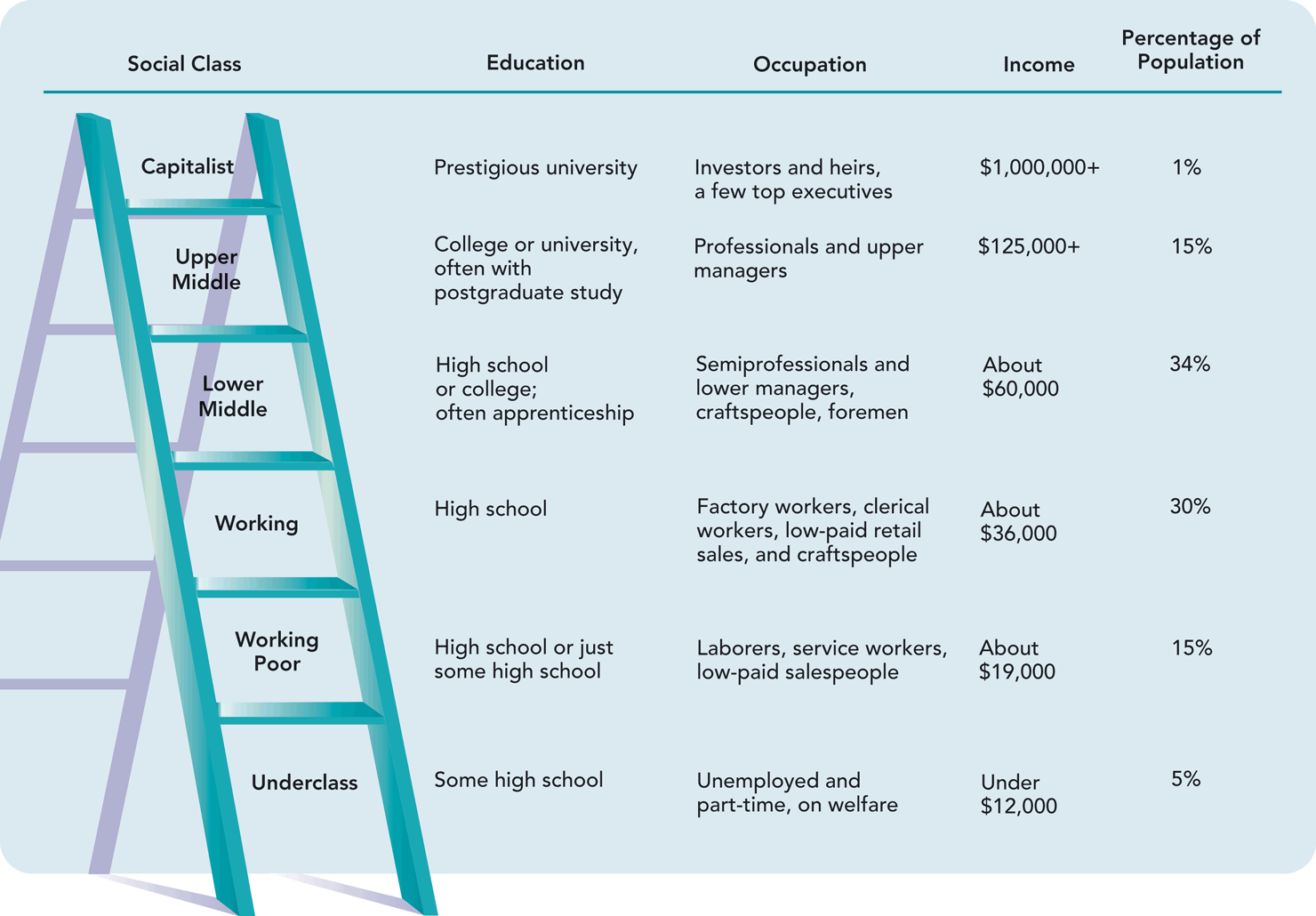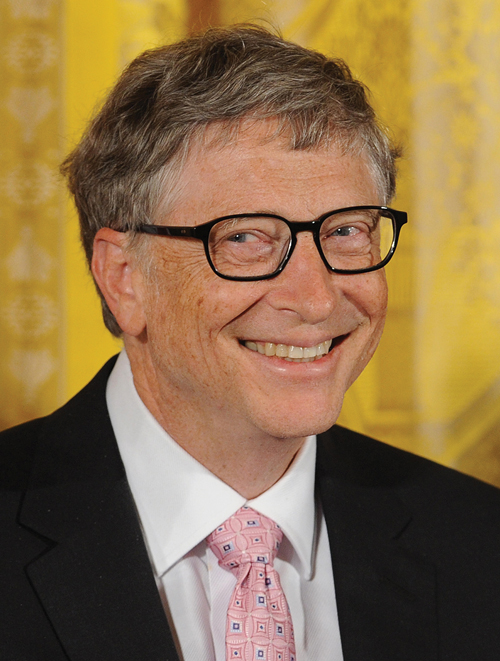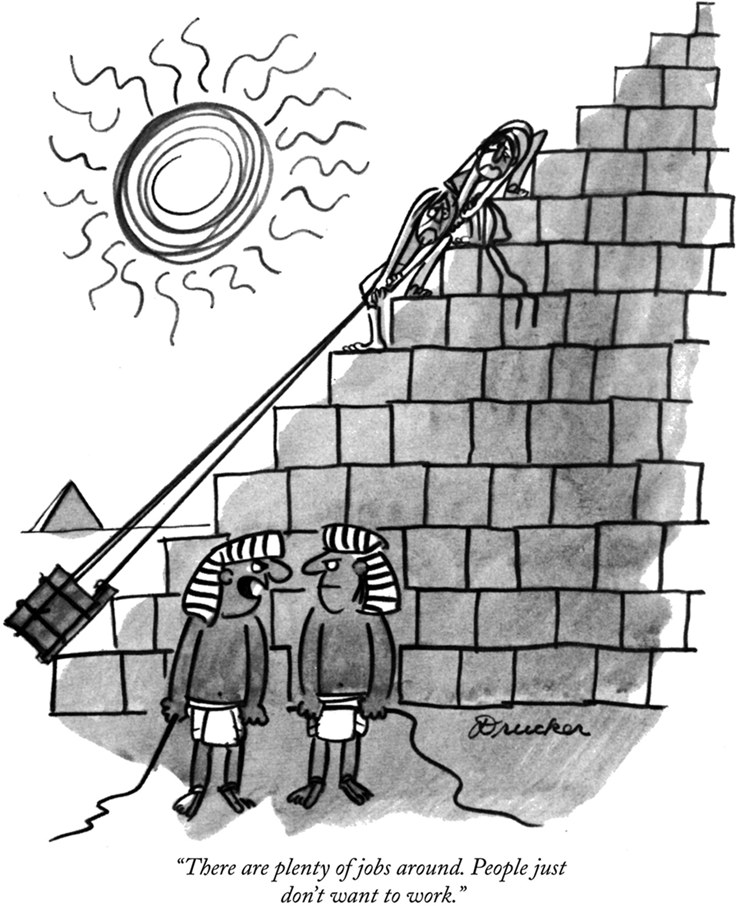Updating Weber
Sociologists Joseph Kahl and Dennis Gilbert (Gilbert and Kahl 1998; Gilbert 2014) developed a six-tier model to portray the class structure of the United States and other capitalist countries. Think of this model, illustrated in Figure 10.6, as a ladder. Our discussion starts with the highest rung and moves downward. In line with Weber, on each lower rung, you find less property (wealth), less power, and less prestige. Note that in this model, education is also a primary measure of class.
Figure 10.6
The U.S. Social Class Ladder

Source: By the author. Based on Gilbert and Kahl 1998 and Gilbert 2014; income estimates are inflation-adjusted and modified from Duff 1995.
The Capitalist Class
The twenty richest Americans have more wealth than all the Americans (160 million) in the bottom half of the U.S. population (Collins and Hoxie 2015). One U.S. family, the Waltons of Wal-Mart Stores fame, has more money than the entire bottom 40 percent of all Americans, more than 125 million of their fellow citizens (Magdoff and Belamy 2014).
These two facts tell you more about the concentration of wealth in the United States than almost anything else I could say. But let’s try anyway: The sliver at the top of the capitalist class, a tiny one-tenth of 1 percent of the U.S. population, is worth more than the entire bottom 90 percent of the country (Saez and Zuchman 2016).
Power and influence cling to this small elite on the top rung of the class ladder. With their vast wealth, its members have access to top politicians, and their decisions open or close job opportunities for millions of people. They even help to shape the consciousness of the nation: They own our major media and entertainment outlets—newspapers, magazines, radio and television stations, and sports franchises. They also control the boards of directors of our most influential colleges and universities. The super-rich perpetuate themselves in privilege by passing on their assets and social networks to their children.
The capitalist class can be divided into “old” and “new” money. The longer that wealth has been in a family, the more it adds to the family’s prestige. The children of “old” money seldom mingle with “common” folk. Instead, they attend exclusive private schools where they learn views of life that support their privileged position. They don’t work for wages; instead, many study business or become lawyers so that they can manage the family fortune. These old-money capitalists (also called “blue bloods”) wield vast power as they use their extensive political connections to protect their economic empires (Domhoff 1990a, 2006, 2014; Lofgren 2016).
At the lower end of the capitalist class are the nouveau riche, those who have “new money.” Although they have made fortunes in business, the stock market, inventions, entertainment, or sports, they are outsiders to the upper class (Peretz 2013). They have not attended the “right” schools, and they don’t share the social networks that come with old money. Not blue bloods, they aren’t trusted to have the “right way” of thinking. Even their “taste” in clothing and status symbols is suspect (Fabrikant 2005). Donald Trump, whose money is “new,” is not listed in the Social Register, the “White Pages” of the blue bloods that lists the most prestigious and wealthy one-tenth of 1 percent of the U.S. population. Trump said he “doesn’t care,” but he revealed his true feelings by adding that his heirs will be in it (Kaufman 1996). He is probably right, since the children of new money can ascend into the top part of the capitalist class—if they go to the right schools and marry old money.
Many in the capitalist class are philanthropic. They establish foundations and give huge sums to “causes.” Their motives vary. Some feel guilty because they have so much while others have so little. Others seek prestige, acclaim, or fame. Still others feel a responsibility—even a sense of fate or destiny—to use their money for doing good. Bill Gates, who has given more money to the poor and to medical research than anyone else in history, seems to fall into this latter category.

The wealthiest person on the planet: Bill Gates, the cofounder of Microsoft, is worth $86 billion. He has also given away $30 billion, more than anyone in history.
The Upper-Middle Class
Of all the classes, the upper-middle class is the one most shaped by education. Almost all members of this class have at least a bachelor’s degree, and many have postgraduate degrees in business, management, law, or medicine. These people manage the corporations owned by the capitalist class, operate their own businesses, or pursue professional careers. As Gilbert and Kahl (1998) say,
[These positions] may not grant prestige equivalent to a title of nobility in the Germany of Max Weber, but they certainly represent the sign of having “made it” in contemporary America …. Their income is sufficient to purchase houses and cars and travel that become public symbols for all to see and for advertisers to portray with words and pictures that connote success, glamour, and high style.
Consequently, parents and teachers push children to prepare for upper-middle-class jobs. Around 15 percent of the population belong to this class.
Gallery
Celebrities and Social Class
The Lower-Middle Class
About 34 percent of the U.S. population are in the lower-middle class. Their jobs require that they follow orders given by members of the upper-middle class. With their technical and lower-level management positions, they can afford a mainstream lifestyle, although they struggle to maintain it. Many anticipate being able to move up the social class ladder. Feelings of insecurity are common, however, with the threat of inflation, recession, and job insecurity bringing a nagging sense that they might fall down the class ladder.
The distinctions between the lower-middle class and the working class on the next rung below are more blurred than those between other classes. In general, however, members of the lower-middle class work at jobs that have slightly more prestige, and their incomes are generally higher.
The Working Class
About 30 percent of the U.S. population belong to this class of relatively unskilled blue-collar and white-collar workers. Compared with the lower-middle class, they have less education and lower incomes. Their jobs are also less secure, more routine, and more closely supervised. One of their greatest fears is that of being laid off during a recession. With only a high school diploma or a fleeting attempt at college, the average member of the working class has little hope of climbing up the class ladder. Job changes usually bring “more of the same,” so most concentrate on getting ahead by achieving seniority on the job rather than by changing their type of work. They tend to think of themselves as having “real jobs” and regard the “suits” above them as paper pushers who have no practical experience and don’t do “real work” (Morris and Grimes 2005).
The Working Poor
Members of this class, about 15 percent of the population, work at unskilled, low-paying, temporary and seasonal jobs, such as sharecropping, migrant farm work, housecleaning, and day labor. Most are high school dropouts. Many are functionally illiterate, finding it difficult to read even the want ads. Believing that their situation won’t change no matter what party is elected to office, they are less likely than other groups to vote (U.S. Census Bureau 2016b).
Although they work full time, millions of the working poor depend on food stamps (cards from the Supplemental Nutritional Assistance Program) and local food banks to survive on their meager incomes (Bello 2011; Carlson et al. 2016). It is easy to see how you can work full time and still be poor. Suppose that you are married and have a baby 3 months old and another child 3 years old. Your spouse stays home to care for them, so earning the income is up to you. But as a high-school dropout, all you can get is a minimum wage job. At $7.25 an hour, you earn $290 for 40 hours. In a year, this comes to $15,080—before deductions. Your nagging fear—and recurring nightmare—is of ending up “on the streets.”
The Underclass
On the lowest rung, and with next to no chance of climbing anywhere, is the underclass. Concentrated in the inner city, this group has little or no connection with the job market. Those who are employed—and some are—do menial, low-paying, temporary work. Welfare, if it is available, along with food stamps and food pantries, is their main support. Most members of other classes consider these people the “ne’er-do-wells” of society. Life is the toughest in this class, and it is filled with despair. About 5 percent of the population fall into this class.

A primary sociological principle is that people’s views are shaped by their social location. Many people from the middle and upper classes cannot understand how anyone can work and still be poor.
The homeless men described in the opening vignette of this chapter, and the women and children like them, are part of the underclass. These are the people whom most Americans wish would just go away. Their presence on our city streets bothers passersby from the more privileged social classes—which includes just about everyone. “What are those obnoxious, dirty, foul-smelling people doing here, cluttering up my city?” appears to be a common response. Some people react with sympathy and a desire to do something. But what? Almost all of us just shrug our shoulders and look the other way, despairing of a solution and somewhat intimidated, perhaps irritated, by their presence. If only they would disappear.
The homeless are the “fallout” of our postindustrial economy. In another era, they would have had plenty of work. They would have tended horses, worked on farms, dug ditches, shoveled coal, and run the factory looms. Some would have explored and settled the West. The prospect of gold would have lured others to California, Alaska, and Australia. Today, however, with no frontiers to settle, factory jobs scarce, and farms that are becoming technological marvels, we have little need for their unskilled labor.